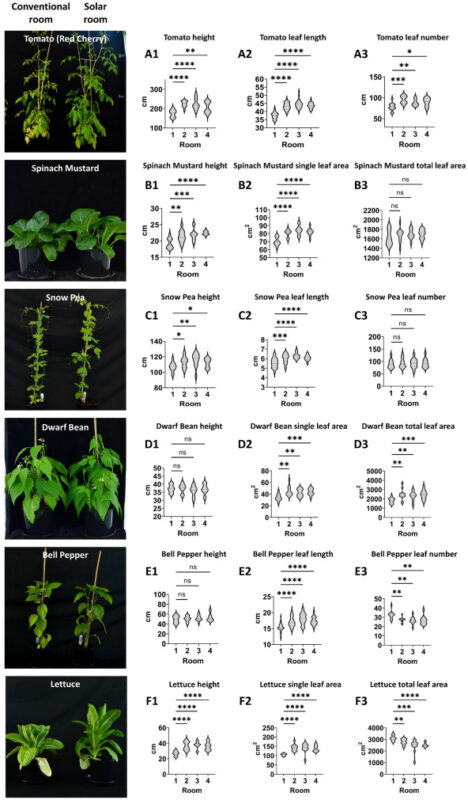Photovoltaic windows can reduce energy consumption in greenhouses by 57%
Developed by a research team including experts from Australian specialist Clearvue, the new PV windows were also able to reduce water usage in a greenhouse by 29%. The group believes that a fully glazed solar greenhouse could offset up to 100% of the energy consumption in worldwide locations by using adaptable and efficient temperature control techniques.

Developed by a research team including experts from Australian specialist Clearvue, the new PV windows were also able to reduce water usage in a greenhouse by 29%. The group believes that a fully glazed solar greenhouse could offset up to 100% of the energy consumption in worldwide locations by using adaptable and efficient temperature control techniques.
Researchers from Australia’s Murdoch University and ClearVue Technologies have developed new solar windows that can reportedly reduce energy consumption and water usage in greenhouses. “The core concept for this project is to harvest food and energy simultaneously so that we can overcome the food, energy, and environment trilemma challenge,” corresponding author Professor Chengdao Li told pv magazine.
To test the proposed innovation, they designed and constructed a greenhouse with high-transparency PV windows placed on the roof and the walls. Throughout two growing seasons, they measured the yield of 18 different crops growing in that greenhouse, along with electricity production and water consumption.
“Solar greenhouses with rooftop-mounted high-transparency photovoltaic modules use a portion of the captured sunlight to generate electricity by the solar cells while allowing the remaining sunlight to pass through into the greenhouse for plant growth and food production,” the team explained. “However, at the present stage, there has been no practical implementation of a fully operational solar greenhouse to assess its actual energy consumption, power generation capabilities, and crop production potential.”
The research-scale greenhouse was built in Perth, Western Australia. It consisted of four rooms, each 8 m long and 6 m wide. Room 1 was glazed with conventional low-iron, ultra-clear glass, while rooms 2, 3, and 4 used solar glass.
Two types of polyvinyl butyral (PVB) designs were used, including PVB-1, a lower doping concentration for higher-clarity windows, and PVB-2, with a slightly higher luminescence. The solar glass in room 2 used two PVB-2 interlayers; in room 3, a combination of PVB-1 and PVB-2 was used, while room 4 used a single PVB-1 interlayer paired with an ordinary PVB interlayer.
“ClearVue Technologies developed a high-transparency PV glass product, designed through the innovative application of advanced glazing using fluorescent concentrator panels, spectrally selective thin-film coatings, and custom-designed silicon-based solar cell modules,” the academics added, noting that the windows have direct visible light transmission (VLT) of around 60% and total (direct plus diffused) VLT of around 70%, with a power conversion efficiency of about 3.3% and electric power output of 30–33 Wp/m2.
Image: Murdoch University, Cleaner Engineering and Technology, CC BY 4.0

A total of 153 clear solar windows were installed in the greenhouse. They were able to power the fans, air-conditioners, shades, and ventilation louvers. Surplus PV-generated energy was also exported to the electricity grid. At night, the greenhouse operation relied on electricity from the grid. Growing season 1 was from July to December 2021, and growing season 2 was from March to September 2022.
“The crops include horticultural crops commonly produced in greenhouse farming and broadacre crops. Strawberry, lettuce, tomato, dwarf bean, spinach, mustard, basil, snow pea, chili, and bell pepper were selected for this study due to their common use in commercial greenhouse farming,” the academics explained. “On the other hand, wheat, barley, canola, lupin, chickpea, ginger, sunflower, and sweet corn were included because they are either broadacre crops or economically significant. While these crops are not typically grown commercially in greenhouses, they are widely cultivated for research purposes, particularly in breeding programs.”
Per the results, the novel structure (rooms 2-4) reduced energy consumption by 57% and water usage by 29%, compared to room 1. Common horticulture crops, such as tomato, dwarf bean, chickpea, lettuce, spinach mustard, and bell pepper, maintained the same yield level in the solar room as in the conventional room. At the same time, snow peas had a 12% yield increase in the solar rooms. Broadacre crops experienced a notable decline in biomass and yield or failed to reach maturity when grown in solar rooms.
Following those results, the team numerically simulated the same structure in different locations worldwide. Namely, they have placed it in Rio de Janeiro, Brazil; Beijing, China; New Delhi, India; Los Angeles, California, United States; New York City, New York, United States; Haifa, Israel; and Paris, France.
“A computing model showed that a fully glazed solar greenhouse has the potential to offset up to 100% of the energy consumption in worldwide locations by using adaptable and efficient temperature control techniques, thereby potentially enabling completely self-sustainable greenhouse farming on a global scale,” the team said.
Its findings were presented in “Transparent solar photovoltaic windows provide a strong potential for self-sustainable food production in forward-looking greenhouse farming architectures,” presented in Cleaner Engineering and Technology.
What's Your Reaction?






























































